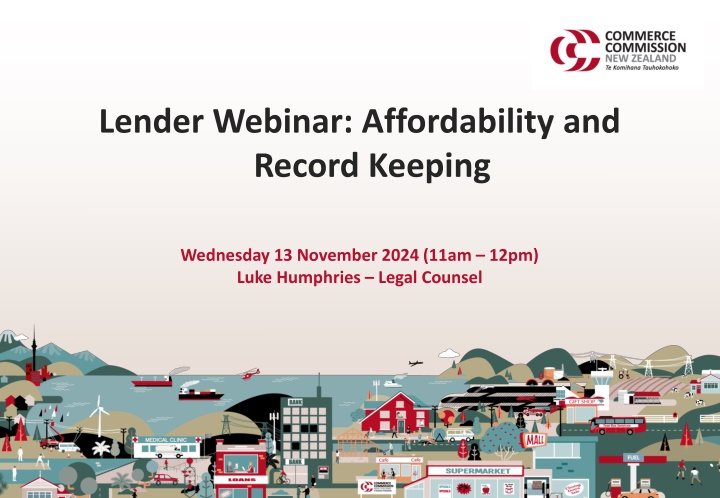
Regulatory Requirements for Lender Affordability Assessment Records
Gain insights into the regulatory context and requirements for maintaining clear, complete, and coherent records in lender affordability assessments. Learn about the shift to a principles-based approach, record-keeping guidelines, and the importance of demonstrating borrower and guarantor capacity to meet obligations without hardship.
Download Presentation

Please find below an Image/Link to download the presentation.
The content on the website is provided AS IS for your information and personal use only. It may not be sold, licensed, or shared on other websites without obtaining consent from the author. If you encounter any issues during the download, it is possible that the publisher has removed the file from their server.
You are allowed to download the files provided on this website for personal or commercial use, subject to the condition that they are used lawfully. All files are the property of their respective owners.
The content on the website is provided AS IS for your information and personal use only. It may not be sold, licensed, or shared on other websites without obtaining consent from the author.
E N D
Presentation Transcript
Lender Webinar: Affordability and Record Keeping Wednesday 13 November 2024 (11am 12pm) Luke Humphries Legal Counsel
Objectives To explain to lenders what the Commission expects to see in affordability assessment records using new guidance material To explain how the Commission uses the Responsible Lending Code and its approach to reviewing affordability assessment records 2
Regulatory context Between 1 December 2021 and 30 July 2024 the regulations set out in detail the prescriptive process that a lender must undertake in order to assess whether a loan is affordable or not. On 31 July 2024 the affordability regulations were revoked. Lenders now have greater flexibility around how they assess the affordability of a loan. With the return to a principles based approach, the Commission has developed additional guidance about what we expect to see in the affordability assessment records. 3
Record Keeping Guidance The records should: Be clear, coherent, and complete, allowing for easy understanding and review. Demonstrate the information relied upon to be satisfied that the borrower and guarantor could meet their obligations. Demonstrate the scope, extent, and method of inquiries the lender made into the borrower and guarantor s income, expenses, and likelihood of repayment, including the use of any minimum surplus, buffers or adjustments. Demonstrate the results of the inquiries: Why the lender was satisfied that it is likely that the borrower will make the payments under the agreement and the guarantor will comply with the guarantee without suffering substantial hardship. 5
Completeness of Records The records should be clear, coherent and complete to show: what inquiries the lender made; and why the lender made the decisions it made; and why it was satisfied the borrower/guarantor could afford the loan repayments. 6
To be satisfied The records should be able to answer the question: How and why was the lender satisfied it is likely this borrower (or guarantor) could make the loan repayments without suffering substantial hardship? 7
Income Assessment The records should demonstrate the inquiries made and information relied upon to determine: The borrower and guarantor s current income level. The sources and stability of the borrower and guarantor s income, including any likely material changes. Any volatile, irregular or variable income and any adjustments made as a result of this assessment. 8
Expense Consideration The records should demonstrate the inquiries made and information relied upon to estimate relevant expenses, including: Necessary expenses to maintain a reasonable standard of living such as accommodation, food, utilities, transport, clothing, medical expenses, costs associated with any dependents such as childcare, etc; Other financial commitments, such as repayments on existing debts; Other recurring expenditures that may impact loan affordability such as tithing and transfers to support family overseas; and Likely changes in relevant expenditures (and why) 9
How the Commission uses the Responsible Lending Code (Code) The code provides: The legislation provides that the Code is not binding. Lenders are able to comply with the lender responsibility principles in other ways. The Code is also not a safe harbour . Compliance with the Code is not deemed to be compliance with the lender responsibility principles (see section 9E(3) of the Act). The guidance provided in the Code is not (and cannot be) an exhaustive statement of what a lender should or should not do in order to be a responsible lender. Evidence of a lender s compliance with the provisions of the Code will be treated as evidence of compliance with the lender responsibility principles, including the specific lender responsibilities (see section 9E(3) of the Act). But evidence of compliance with the Code will be weighed against other evidence. Page 5 Responsible Lending Code 10
Questions 11
